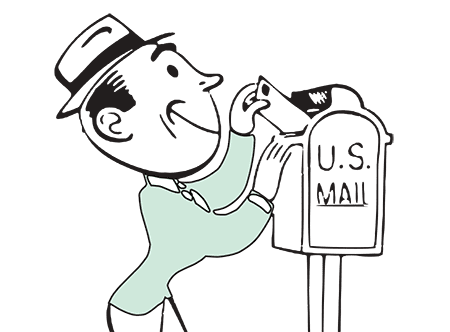The buzz these days is all about digital marketing and how to do it right. But what about good old print? You need to get it right because print is an investment. Just because it’s the longest-running show in town doesn’t mean its hottest techniques or FAIL Blog pitfalls are self-evident. Save time, trouble, and money, and stay aware of the biggest print marketing mistakes before you get started. (Thank us later by buying our envelopes!)
6 Biggest Print Marketing Mistakes
#1 – Spelling and grammar mistakes
Do not leave a stone unturned when it comes to copy—especially spelling and grammar. Make gaffes in either of these areas, and you’ve instantly lost credibility. Marketing audiences do not generally think spelling and grammar mistakes are cute. Mistakes project carelessness, lack of attention to detail, and incompetence. Spelling and grammar are part of your image and can make a strong first impression. Invest in writing software or download an app like Grammarly if you need to, and spell well!
#2 – Not understanding image format
Image format is one of those little details that can make or break a campaign. Here are a couple of important things to remember if you don’t want to spend thousands of dollars sending a carefully crafted brochure with fuzzy, dorky-looking images and awkward colors.
First, .png and .jpg formats for images may give you a great product on the screen, but fail to translate well to print. Understand exactly the high-resolution image format you need to get crystal clear images. No pixelation allowed! As we are long past the days of Atari, we are long past the days of home-made—or home-made-looking—marketing campaigns.
Second, your color format on a computer screen is RGB, or red, green, and blue. But IRL (in real life), it is CMYK, or cyan, magenta, yellow, and black. All of your campaigns need to be tested in the CMYK format before hitting the green button and sending everything to press. It’s just too easy nowadays to create a highly professional product, and consumers can tell the difference, so don’t sell yourself short.
#3 – Forgetting the bleed
We’ll keep this one short and sweet: leave at least 3 mm for bleed along every side of your campaign, and double-check with your printer that all is in order. Otherwise, your design will literally get cut short! Very complex designs should leave even more breathing room—4 to 6 mm. Bleed is printing that goes beyond the area of where the sheet will be trimmed. If you want an envelope to be printed in edge-to-edge design, including a bleed area is essential.
#4 – Visual overload
The author of this post once received a youth group calendar mailer from a church, inviting kids to join fall programming. The calendar format was certainly out-of-the-box. So much so, there was almost no more “box” left to the campaign. There were so many bright colors, curvy lines, crisscrossing arrows, exclamation points, all caps, and about a dozen fonts, it was like trying to interpret a psychedelic game of Snakes and Ladders, not a calendar. Too much design, too much copy, too many fonts, or too much color can shoot beyond appealing and cause visual overload. To be attractive means that your print campaign is eye-catching without being eye-harassing. Readability and flow are paramount.
It’s a great idea, here, to work with a professional designer. If you think you can do an expert job, but you’re not an expert, then you’re not an expert!
#5 – No clear CTA
Does your print marketing campaign easily lead to your call to action? Your campaign materials should contain plenty of accessible (and accurate!) contact information, such as a telephone number, email address, website, social media handle, and/or code to join a texting service. It should also lead toward a goal—usually a sale, a connection, or a commitment.
Put yourself in your reader’s shoes, following each of the leads you throw out. Check for “under construction” websites or dead ends. Make sure the thread is easy to follow and comes with a time limit. If you’re asking for contributions, for example, do readers know exactly how long the fundraising campaign is running, how to give immediately, how to pledge a future gift, how to find out more, and how to contact someone with a question or problem?
A clear CTA means your reader knows what to do and doesn’t get log-jammed at any point.
#6 – Missing the audience
All print marketing campaigns are created from insight into your target market. This means that your copy is directed straight to the ear (or eye) of the kind of person you’d like to benefit from your message or offer. You are not going to speak to retirees the same way you speak to parents of young children. You will not speak to dental patients the same way you’ll speak to members of a faith community. Words don’t equal power unless they are crafted with meaning specifically for the audience.
Images are similar. Placing images or photos into a campaign for their own sake, without a communication or design purpose, will stick out like a sore thumb, and might contribute to visual overload. Your images also need to appeal to your audience.
Most importantly…
When in doubt, go clean, go clear, and go simple. Appealing to a market isn’t the same as being cheesy or cloying, and no one likes to be condescended to. You will always approach your mark when you’re sincere and real, and keep things simple. Add flourish from there.
When you’re ready to add the envelope, you know where to look. Letter Jacket Envelopes offers free shipping on the first order and can customize all of our envelopes to fit your brand and message. Give us a shout!



